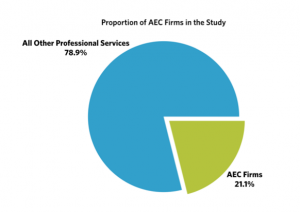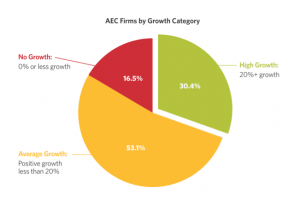The 2018 High Growth Study took a deep dive into the architecture, engineering and construction industries to uncover some very revealing statistics about marketing and revenue generation. The Hinge Research Institute surveyed 211 firms, almost two thirds of which provided detailed financial data. These firms had more than $11.6 billion in combined annual revenue and employed more than 194,000 people full time.

Now in its third year, the High Growth Study encompasses all professional services: accounting, architecture, construction, consulting, engineering, finance, legal, and technology. More than 1,000 companies participated in the study, and firms offering architecture, engineering and construction services represented 21.1% of the sample. The companies ranged in size from micro firms with less than $1 million in annual revenue to large companies generating $50 million or more each year.
CEOs, presidents and other top executives participated in the study, providing insight into how their companies grow, which marketing techniques work and how they view competitive threats. Best of all, the study details why some firms in the industry grow at much higher rates—roughly three times higher—than their peers, and what they are doing to make that growth happen.
An Industry Facing Change
Architecture, engineering and construction firms saw median annual revenue growth dip to a three-year low of 9.1%, down from 10.3% in 2016. The industry was in the middle of the professional services pack, ahead of legal, accounting and financial services firms but behind consulting and technology companies. The slowdown matched a broader trend among professional services as a whole, where growth slowed in 2017.
In addition to slower rates of growth, AEC firms face a variety of challenges, including a shortage of top talent, increased competition from both large and small firms, downward price pressure and unpredictability in the marketplace.
Meet the High-Growth Firms
Despite these challenges, nearly one-third of AEC firms experienced compound annual growth of at least 20% for three consecutive years. We call these the high-growth firms.

These rapidly growing firms had a median annual growth rate of 36.7%—three times the industry average. Nearly 50% of these high-growth AEC firms were either mid-sized or large firms, demonstrating that growth can be achieved at any size.
What are these high-growth firms doing differently? One of the primary missions of the 2021 High Growth Study was to answer this question.
The High-Growth Perspective
High-growth firms see the marketplace and the competitive landscape very differently than their no-growth peers. For example, while low-growth firms worry about numerous, wide-ranging threats, high-growth firms focus on understanding the marketplace.
Download the High Growth Study: Architecture, Engineering & Construction Executive Summary
High-growth firms react to these threats differently, too. For example, they are almost four times as likely to do frequent research on their target markets. High-growth firms are also far more likely to specialize, though they usually avoid specializing in a particular industry. They also enjoy a sizable skills advantage in virtually all areas of business development, including networking with peers in person, writing technical content and speaking in public.
High-Growth Marketing
AEC firms as a whole do more traditional marketing and are slower to adopt digital or content marketing than other professional services industries.
High-growth firms approach marketing differently, too. Both high- and no-growth firms invested similarly in marketing, but high-growth firms allocated those dollars to different priorities. For instance, high-growth firms are twice as likely to use any given digital or content marketing technique.
Both high-growth and no-growth firms still do traditional marketing, but high-growth firms are more likely to favor conferences, events, assessments and consultations—activities that put them directly in front of prospects. No-growth firms favor collateral and sponsorships, which typically are slower to produce new business.
By studying how high-growth firms view the competitive landscape, go to market and interact with prospects, your company can create more effective marketing, sales and revenue strategies. Hinge makes an executive summary of the the 2018 architecture, engineering and construction research available free. Download it today.
Additional Resources:
- Download the Executive Summary of the 2021 High Growth Study Edition to find out what propels high-growth firms into the stratosphere.
- Learn how to uncover your firm’s true differentiators with Hinge University‘s Differentiation, Positioning & Messaging Course.
How Hinge Can Help:
Hinge helps professional services organizations create and implement a research-based strategy to increase visibility and growth. Hinge’s Visible Firm® Program is the leading marketing program for organizations that want to market themselves like industry leaders. Ask about it today!

